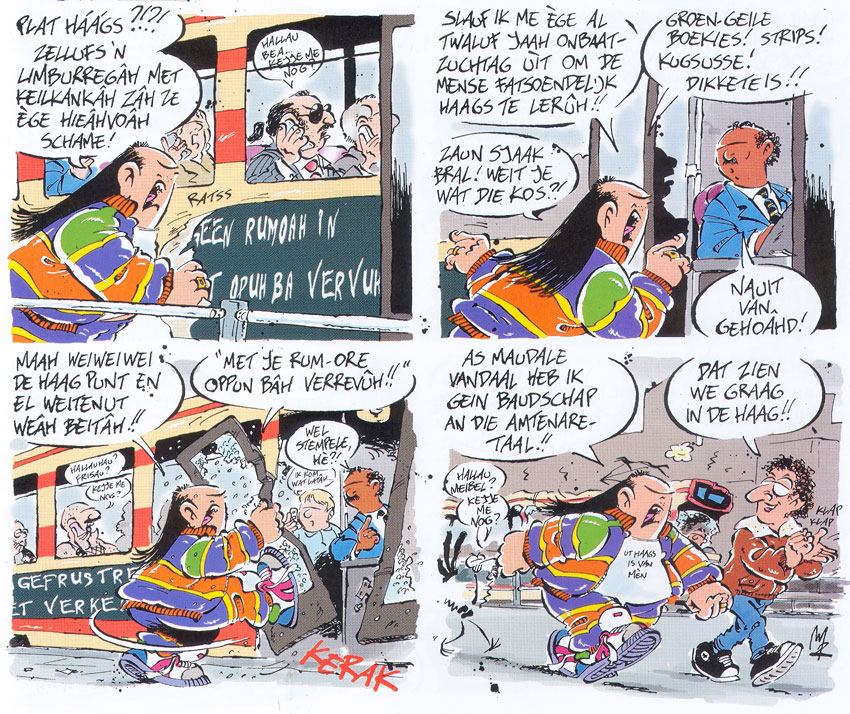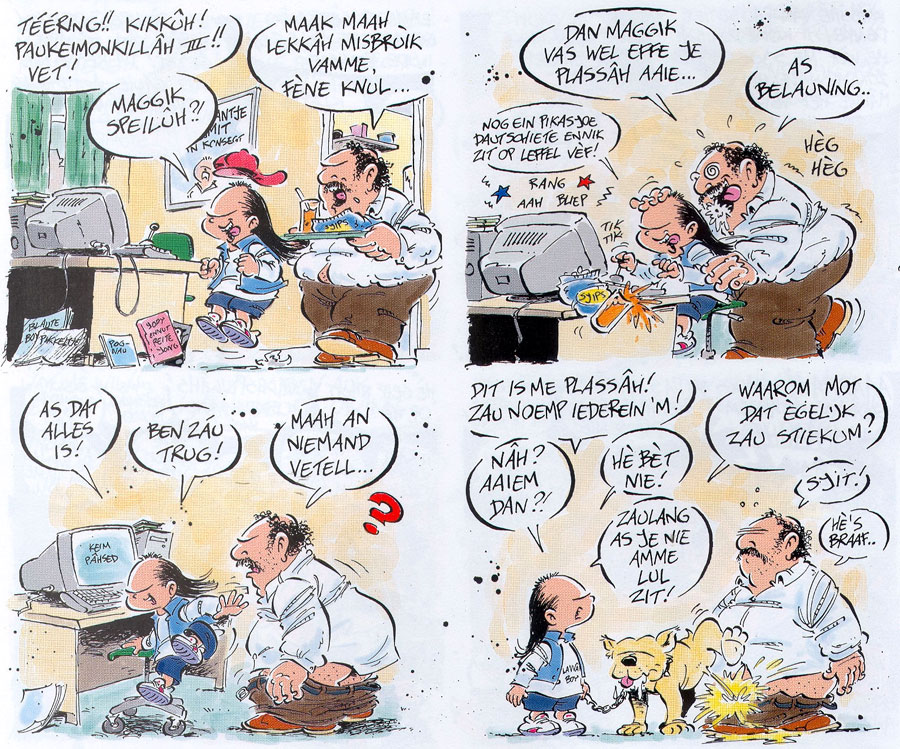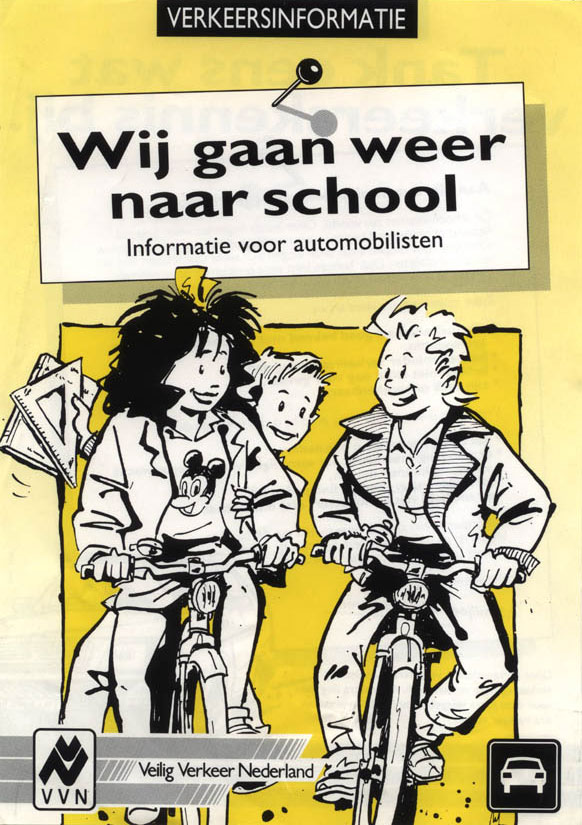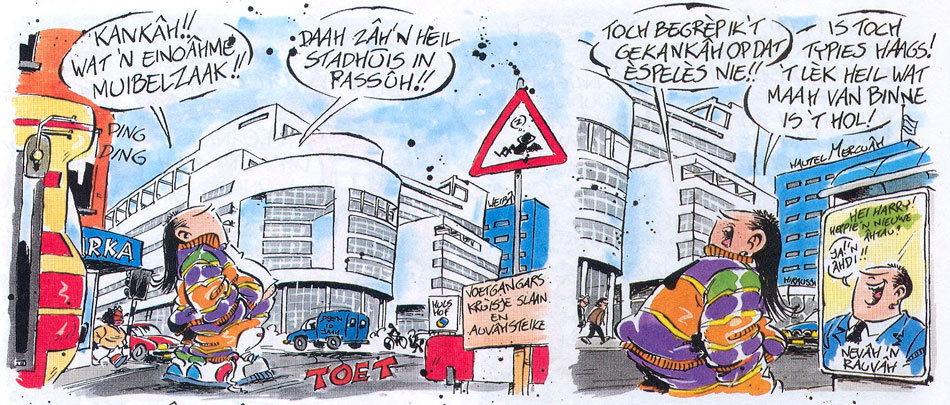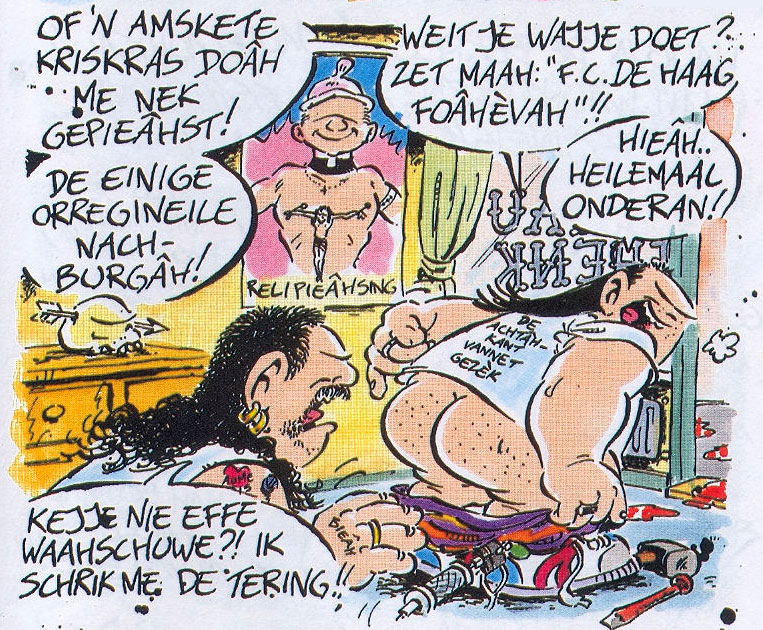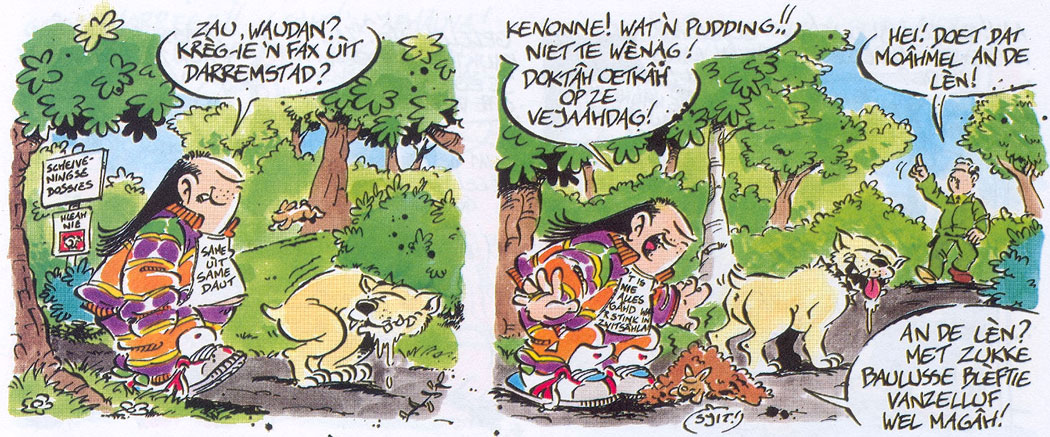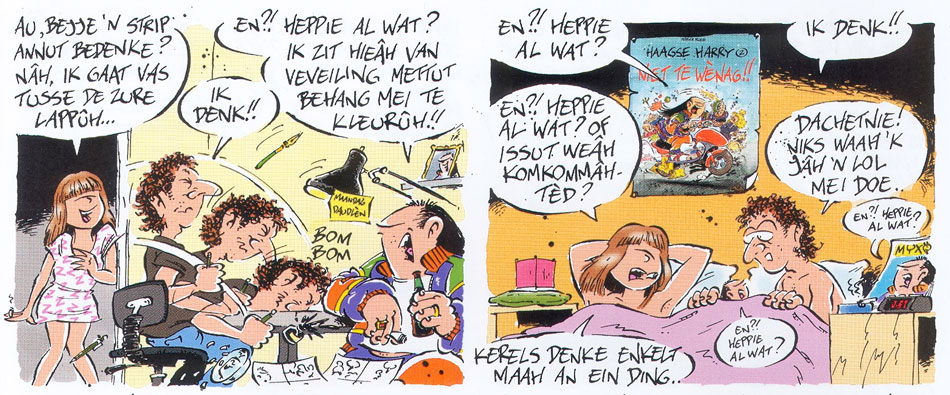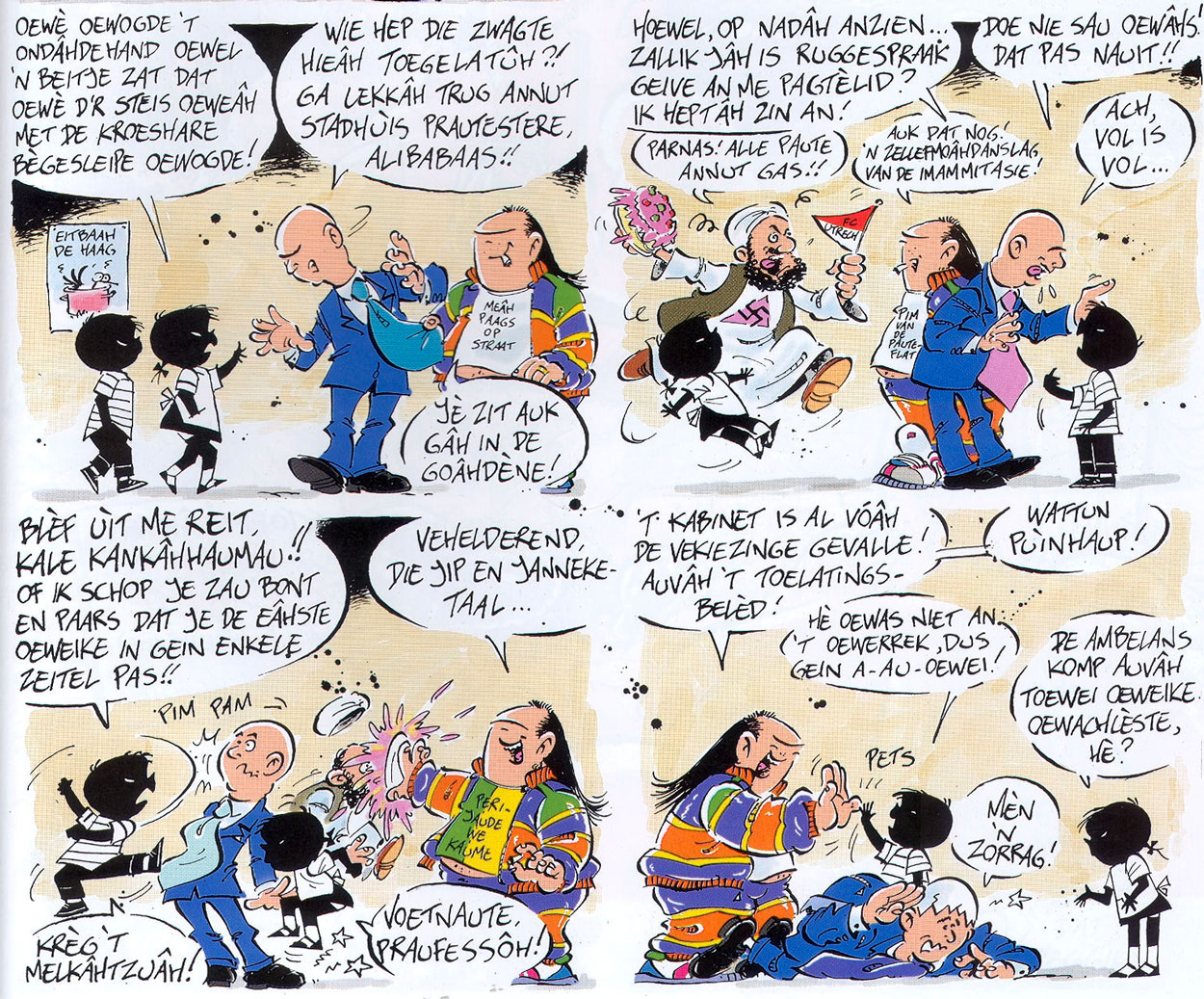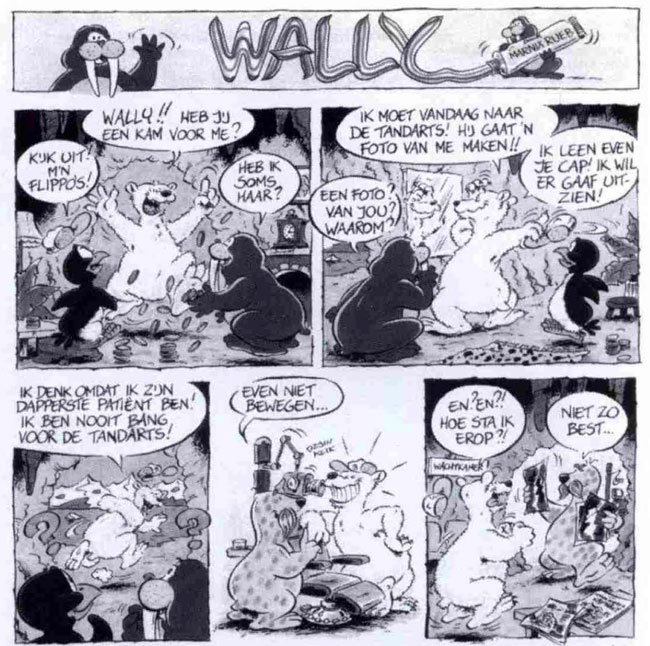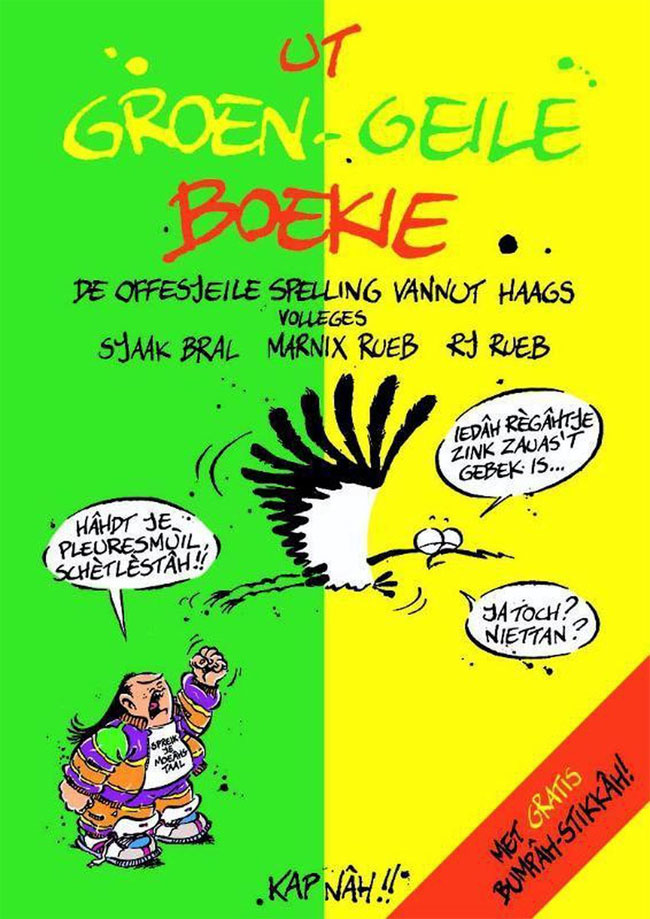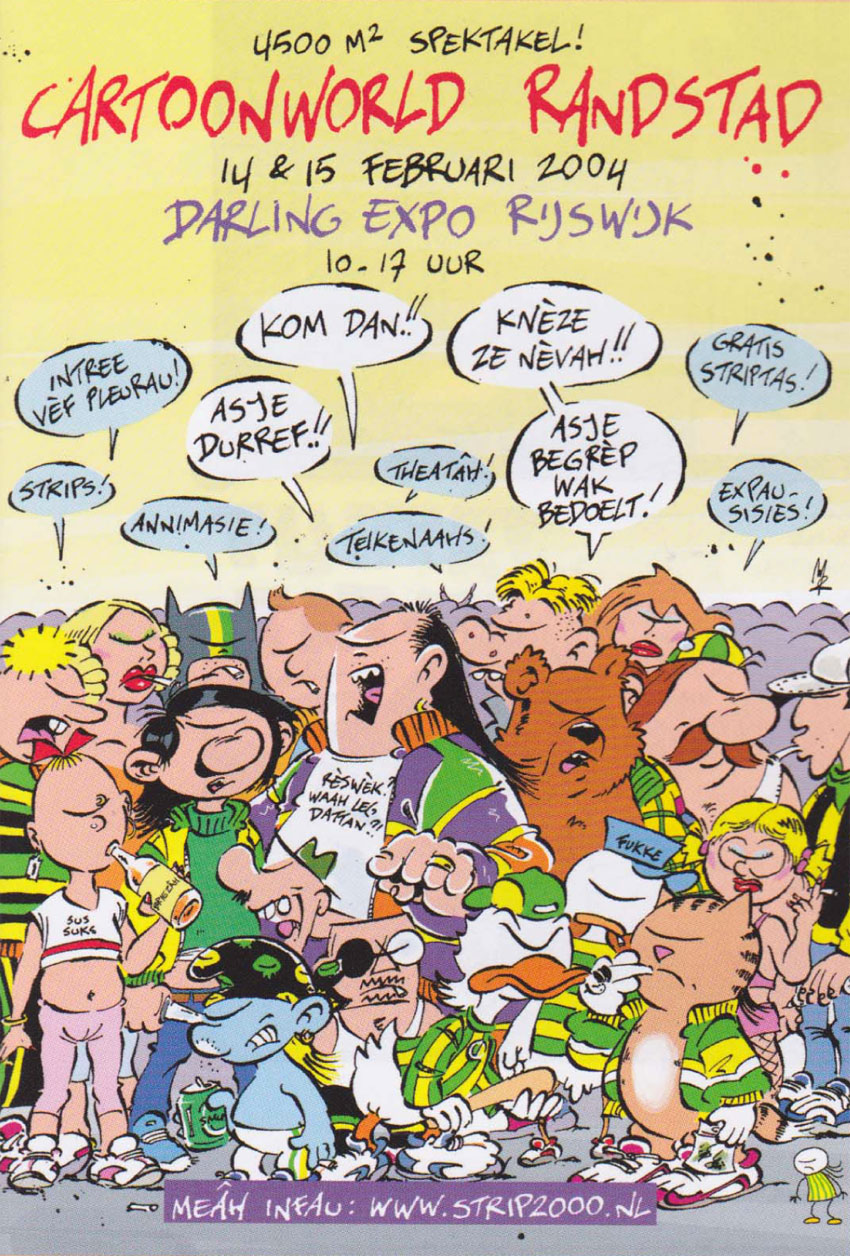Haagse Harry behaves like a hooligan against a bus advert in "Haguenese slang", claiming that he has promoted "decent Haguenese" for years. Marnix Rueb has a cameo in the final panel.
Marnix Rueb was a Dutch commercial illustrator and comic artist, known for his signature series 'Haagse Harry' (1991-2014). Self-published under his own Kap Nâh!! imprint, this gag comic about a stereotypical citizen of the Dutch city The Hague is completely written in local slang. Set in a sleazy, but recognizable version of the city, 'Haagse Harry' satirizes its citizens, trends and events. With his comic, Rueb managed to perfectly capture the Haguenese spirit, making it a cult hit among local readers, but surprisingly also a national bestseller. Over the years, the character has become part of The Hague's local folklore, even having its own statue in the city. As promoters of the Hague dialect, Marnix Rueb and his brother Robert-Jan were also driving forces behind the local language dictionary 'Ut Groen-Geile Boekie'.
Early life and career
Contrary to what one might assume, Marnix Rueb wasn't born in The Hague, although he lived in the city from an early age. He actually saw the light in a smaller town, Oegstgeest, in 1955. While his comic was written in The Hague slang, Rueb didn't hail from a working class background either, as he was raised in the more posh neighborhood of Benoordenhout. His father Theo Rueb was a children's judge, his mother died when he was still young. Marnix's older brother Alexander (1953) later became a notary, and his younger brother Robert-Jan (1959) a journalist, editor and cultural entrepreneur, with whom Marnix regularly collaborated during his career.
Young Marnix enjoyed comics. As a child, he read the Disney weekly Donald Duck and the Belgian comic magazine Robbedoes, and he collected 'Suske en Wiske' books. Many of his school books were filled with scribblings, doodles and dirty jokes. Among his main graphic influences were Walt Disney, Willy Vandersteen, Albert Uderzo, Marcel Gotlib and especially André Franquin and Jack Davis. Later in life, he also expressed admiration for Peter de Wit, Hein de Kort and Mark Retera.
In his later cartooning career, Marnix Rueb was able to deal with his own past by ridiculing child molesters.
While aspiring to become a cartoonist, Rueb walked a wobbly path until he eventually realized his dream. In high school, he had to repeat third and fourth grade. Soon after, he started to rebel against the rigid school rules and eventually dropped out. In higher education, he took a course in advertising art and photography, but didn't complete this schooling either. For a couple of years, he wandered around, working several odd jobs, including bookkeeper in a warehouse, concrete pourer and freelance photographer.
In 1985, the well-known children's book writer Yvonne Keuls released the novel 'Annie Berber en het Verdriet van een Tedere Crimineel', in which a children's judge molests several of his young clients. The character was directly based on Rueb's father, who in 1983 had been forced into early retirement as a result of these accusations. Initially, Rueb defended his dad, but in reality he too was a victim of incest. While the scandal broke, his father turned out to have taken sexual advantage of other children too. In light of these dark revelations, Rueb's initial struggles in school and at the job market could be seen in a different light. Comedian and close friend Sjaak Bral said that Rueb had a solitary personality, and preferred to find escapism in his own little world behind the drawing table. The pitch black comedy in 'Haagse Harry' has also been interpreted as a way to deal with personal traumas.
'Wij Gaan Weer Naar School'. Marnix Rueb's famous artwork for the traffic safety campaign VVN.
Commercial art
By the late 1980s, Rueb found a job more to his liking as a commercial illustrator. One of his best-known illustrations was for Veilig Verkeer Nederland (VVN), an organization promoting traffic safety for children. The drawing featured a group of children preparing for the new school year, under the caption: "Wij gaan weer naar school" ("We're going back to school"). For several years, after school holidays, the drawing was featured on billboards all over The Netherlands.
Rueb also made designs for jigsaw puzzles with popular characters from Hanna-Barbera's 'Tom & Jerry' and 'The Flintstones', Jim Henson's 'Sesame Street' and Matt Groening's 'The Simpsons'. As an artist, Rueb was completely self-taught. He learned his craft by observing and imitating professional cartoonists. When asked whether he could draw realistically, he bluffed his way through the commissions. Initially, Rueb wanted to match the graphic swiftness and detail of André Franquin, but he soon realized that even if he reached this level, all he had was a decent but lifeless imitation. Rueb therefore settled on a more loose, spontaneous and personal drawing style. Several of his drawings feature ink blots - little "mistakes" he kept in as his personal trademark.
Despite being self-taught, Rueb's graphic skills were well-appreciated by his clients. Interviewed by Rob van der Nol in Stripschrift issue #298 (30 March 1997), he claimed that his artwork for 'The Simpsons' satisfied the franchise owners so much that he was offered the opportunity to come and work for them in the USA. Nevertheless, he didn't really enjoy working with licensed characters, since he had to follow strict guidelines. Sometimes he was forced to change an entire illustration, because his clients felt certain scenes weren't family-friendly enough. Rueb recalled, for instance, that he wasn't allowed to depict Tom & Jerry in violent situations with weapons and anvils. Most of the time, he was merely commissioned to make designs, while the artwork was altered and finished abroad. At a certain point, the Dutch licensee lost the rights to many of the franchises Rueb drew. As a result, the firm began releasing products with artwork that mimicked the Disney style and characters, but then slightly altered. Rueb strongly advised him to discontinue this practice. When the man found himself in copyright infringement trouble, he asked Rueb to sign a declaration that it was he who had taken the initiative. Rueb refused and promptly broke all ties with him.
The original 'Haagse Harry' gags appeared with red spot colors.
Haagse Harry
In the early 1990s, Rueb became house cartoonist of the free monthly magazine Doen, of which his brother Robert-Jan was chief editor. Doen promoted weekend activities in and around The Hague. For the October 1991 issue, Rueb was asked to liven up an article about a poetry event. He drew a cartoon about a man with a Neanderthal-like brow reciting poems in The Hague slang. The character was derived from doodles Rueb made while being on the phone. His colleagues enjoyed the cartoon and asked him to use the character more often, first in illustrations and then as a comic strip. Rueb named his character 'Haagse Harry' ("Haguenese Harry"), an anti-hero with a street attitude. Harry is an unemployed, pot-bellied and pony-tailed rascal, always seen in tracksuit and sneakers. Smoking, boozing, visiting prostitutes and hitting the clubs are his favorite pastimes. Naturally, he supports real-life soccer club ADO Den Haag, though sometimes more to perform hooliganism than to watch a game. The loud-mouthed lout isn't afraid to speak his mind and always does so in his coarse, uncultivated dialect.
Haagse Harry and his girlfriend Bianca.
The 'Haagse Harry' comic has a minimal cast of secondary characters. Harry's girlfriend Bianca shares many of his personality traits. He frequently hangs around with white, black and Arabic friends, most of whom never received a name. The only exception is Brian, a black man with a cap. Harry's mustached uncle Arie has frequent generational arguments with his nephew. In several gags, a heron can be spotted in the background as a nod to the bird in The Hague's official coat of arms. As a running gag, the bird is always the victim of horrific accidents or violence - symbolic for Rueb's raw and anarchic portrayal of the city. In 'Haagse Harry', The Hague is depicted with filth-ridden streets, crime and locals either argueing or enjoying hedonistic activities. For inspiration, Rueb didn't have to look far. Throughout his life, he had observed hundreds of people like Harry. When he looked outside his window from his Schilderswijk home, he noticed countless more. The backgrounds in 'Haagse Harry' are also directly based on real-life hotspots in The Hague.
Several episodes are based on national or local news stories. A recurring gag is the seemingly never-ending construction work on a tunnel in the city. The Hague's mayor (at the time Wim Deetman) and other city officials often have cameos. One time, the real-life Deetman had posed with a man for a photograph, but when the picture was snapped, the citizen suddenly exposed his penis. Rueb made reference to this scandal by letting Harry pose with Deetman and do the same. Other episodes have featured guest roles of the Dutch royal family, Prime Minister Jan Peter Balkenende and darts champion Raymond van Barneveld. Since many 'Haagse Harry' gags unavoidably dated quickly, Rueb sometimes altered dialogue or redrew panels for album compilations to make certain references more timeless. With some gags, however, this was impossible without changing the entire content. He collected these gags in a special "left-overs" album for the fans, titled "Kompleit Baggâh!" (2005), in which Rueb added some additional context. The same album also featured 'Haagse Harry' gags rejected by either his editors or the artist himself, when they were beyond his personal standards.
Real-life hotspots in 'Haagse Harry'.
'Haagse Harry' proved the perfect vehicle for all of Rueb's cynical observations about politics, religion, sports, welfare, multicultural society and hollow celebrity culture. In one gag, Harry is confronted by a city guard for making a parking violation. Harry protests that the officer doesn't even have a gun, whereupon he replies: "But I do have a mustache. I'm a city guard. That's when they give unemployed people a uniform so they can snarl at other unemployed folks." Many readers interpreted Harry as Rueb's alter ego. The artist acknowledged that Harry reflected many of his irritations. Yet contrary to him, Rueb could still see things in perspective, offering room for nuance. And while he thought up most of his own gags, some ideas were suggested by Rueb's good friend Sjaak Bral, who enjoyed fame as a comedian. They had a gentlemen's agreement that they could both use each other's jokes in their respective professions.
While 'Haagse Harry' is a one-page gag comic, Rueb had a different approach than most cartoonists in the genre. He disliked comics where the punchline in the final panel is the only joke and all other panels only serve as a predictable build-up. Rueb deliberately divided each page in six panels. He didn't want to be bothered with panel rhythm or compositions, since this would only distract from the plot. He regarded each episode as six individual cartoons grouped together into a narrative. Each panel had to be funny on its own. He stacked them with hilarious dialogue and amusing visual comedy. Extra jokes were added in background signs and on Harry's shirt. Rueb didn't care about continuity and deliberately changed the slogans on Harry's clothing in every panel. Well aware that all this text might drown out the artwork, he often had to shorten his dialogues to still have room for drawings. Rueb preferred to let his characters wander around and the narratives be driven by their personalities and snappy comments. This gives the gags a more slice-of-life style, making the series more recognizable and relatable.
Haagse Harry: language
Standard Dutch is almost completely absent in 'Haagse Harry'. Every sentence is raw, unfiltered Haguenese, spelled phonetically. Interviewed by Peter Breedveld in Stripschrift #374 (March 2006), Rueb explained that people from The Hague use more synonyms to describe people and things than in any other city. To him, this is what makes Haguenese unintentionally funny. The juicy slang adds to the comic's regional flavor. As an absurd twist, even people from more civilized backgrounds, like the mayor and the Royal Family, speak Haguenese in 'Haagse Harry', and express the same stereotypical combative, cynical but jovial attitude as the other citizens. Rueb collected many Haguenese expressions he overheard in everyday conversations, and categorized them by topic in a personal database. Other words came from his own creativity. In his opinion, Haguenese was easier to transcribe phonetically than the Amsterdam or Rotterdam dialect. Still, he thought hard on how to convey a certain pronunciation. Once he considered adding audio recordings of the dialogues to the comic books, but this proved too impractical. Instead, he consulted dictionaries, even in other languages like French, to see how linguists wrote down certain vocal sounds phonetically.
Haagse Harry gags make use of typical Haguenese metaphors and puns.
Rueb attributed the success of his comic first and foremost to the addictiveness of Haguenese speech. Several Dutch comedians, like Paul van Vliet, Harrie Jekkers and Van Kooten & De Bie often used it for humorous effect. Before 'Haagse Harry', there had already been a comic strip in Haguenese, published in Yes Baby, an obscure 1980s cultural newspaper. In the previously mentioned 2006 Stripschrift interview, Rueb said that he knew the artist, but couldn't recall his name. He reflected that it was a well-made comic, which unfortunately didn't have much impact. Rueb attributed this to the more rudimentary graphic style and the fact that its slang "didn't went as far" as his own comic. Indeed, the slang in 'Haagse Harry' is so thick that even people from The Hague sometimes have difficulty deciphering it. To confuse readers, Rueb also threw in words from other languages, and let foreign characters speak mangled Haguenese. In order to properly understand the dialogue, he advised people to read the comics out loud, an interactive experience that also contributed to the popularity of 'Haagse Harry'.
Haagse Harry: success
Soon after its debut in Doen magazine, 'Haagse Harry' (1991-2014) became a cult series. Since each issue was freely available, it reached many people in the city, who only read it for 'Haagse Harry', ripped its page out and threw the rest of the paper away. Within no time, the comic wasn't only popular in The Hague, but also in the rest of The Netherlands. Rueb heard that people often sent it to friends or relatives who moved away from the city, to help them cope with homesickness. In 1994, Rueb decided to release a compilation comic book. The first 'Haagse Harry' book was printed in black-and-white with a print-run of 10,000 copies. Rueb estimated that, with a little luck, half of them might get sold, getting him out of the costs. Much to his surprise, according to legend, all were sold out within a hour! Eventually more than 100,000 copies flew over the counter, a remarkable feat for a debut comic in a regional dialect, released in a time when comic book sales were in decline.
Cameo of the cartoonist with writer's block.
Having learned from his previous negative experiences with publishers, Rueb established his own publishing company, Kap Nâh, named after Harry's catchphrase: "Kap Nâh', meaning as much as 'Stop Now', or loosely translated: "Quit saying such nonsense". Harry usually says it when he dismisses some news or remark he doesn't believe or agree with. Over the years, several additional volumes of 'Haagse Harry' followed, the second one even surpassing 140,000 sold copies. Soon Rueb was a local celebrity in The Hague, while his character became part of city folklore. He was asked for book signings not only in comic stores, but also in regular bookshops. During public appearances, he sometimes brought along an actor in costume, Jeffrey Huf, who played Harry with his distinctive dialect. 'Haagse Harry' inspired a stream of merchandising, including greeting cards, school agendas, T-shirts, caps, ties, socks, figurines, mousepads and a puzzle. Harry also lent his image to a 1995 anti-fireworks campaign. For Rueb this was a personal matter, since he had once visited a hospital where victims of fireworks accidents were treated.
Yet Rueb was cautious not to exploit Harry into infinity. He rejected all offers from political parties. Even well-intended campaigns sometimes received his veto, like a request to promote proper garbage bag use. In Rueb's opinion, this would clash too much with Harry's anti-authoritarian stance. When Doen folded in 1997, Rueb lost his main promotional tool, although he refused to take 'Haagse Harry' to a daily paper or weekly magazine. He knew that the deadline pressure would exhaust him and readers might grow tired of the dialect-driven gimmick. Instead, Harry continued his shenanigans in the monthly TvFilm, the homeless paper Straatnieuws, De Posthoorn and the pop-culture magazine Zone 5300.
Haagse Harry and the Royal family. Harry walks off with Princess Maxima (nowadays queen) and Queen Beatrix (nowadays former queen), while Prince Willem-Alexander (nowadays king) is left crying.
Haagse Harry: controversy
While no other comic strip is so strongly associated with The Hague as 'Haagse Harry', Rueb didn't turn it into a tourist guide. Under his pencil, the city is a sleazy place, where everybody litters, beggars sit on street corners and criminals rob passersby. Hooligans smash other people's property, while brothels and coffee shops are everywhere. People of different ethnicities get into arguments with each other, using sexist, racist, homophobic and other discriminatory terms. Mayor Wim Deetman and other members of the city council are portrayed as hypocritical, out-of-touch politicians. Queen Beatrix, Crown Prince Willem-Alexander and Princess Maxima (nowadays king and queen) appear in degrading situations. In one gag, Harry goes to the funeral of Prince Bernhard and is disappointed by the sober ceremony. Yet since the late prince "had so many wrong friends and activities, while living off welfare", he considers him "an equal". Even regular cast members are far from role models. In one gag, uncle Arie turns out to be a pedophile. And Harry takes pride in being a hooligan and whoremonger. He's far from intelligent either. Several fights break out because he misunderstands other people's intentions, and vice versa. In general, the comedy is vulgar, cynical and pitch black.
In his comics, Marnix Rueb poked fun at each and everyone. This 2002 comic from Haags Straatnieuws features far-right politician Pim Fortuyn feeling outraged that "two black people" (actually the children's book characters Jip en Janneke by Annie M.G. Schmidt and Fiep Westendorp) have entered the room. At the time, populist politicians like Fortuyn were often accused of using simple language and simplistic opinions to appeal to voters, nicknamed 'Jip and Janneke' language by journalists. Harry also confronts a Muslim fundamentalist in the same sequence. This comic ran in Haags Straatnieuws a few days before Fortuyn was murdered. As a result, the entire print-run was withdrawn.
Yet Rueb didn't want to hold himself back. In his opinion, people from The Hague plain simply are very direct, aggressive and verbally creative. Although people from Amsterdam also have a reputation for waspish comedy, Rueb preferred Haguenese, since it expresses more empathy underneath the seemingly insulting remarks. All is done more in good fun. He used this trait for Haagse Harry too. Whether he faces a government official, a police officer, old ladies, children, immigrants or even his own girlfriend, Harry simply blurts out what he thinks. This sometimes gets him into trouble, but Harry doesn't mind. In many gags, he even shows respect to people he was yelling at a few panels earlier, proving that he actually enjoyed the verbal sparring match. Rueb explained that Harry doesn't mean most of the things he says: "He often uses the prefix 'cancer' to describe something that irritates him, but devoid of any actual reference to the disease." On the same token, Harry's life philosophy is that he dislikes everyone equally, and with love. This might also explain why, in the comic, few people are actually fazed by what he says.
Despite its offensive depiction of The Hague, many citizens actually praised Rueb for perfectly capturing their attitude, folklore and language. He didn't sugarcoat their city and its problems, but presented it in an honest, "warts and all" manner. Some fans congratulated him for making The Hague, particularly its dialect, hip and socially acceptable again.
'Wally'.
Wally
While 'Haagse Harry' is Rueb's signature work, he also made a children's gag comic, 'Wally' for the local magazine Walrus. The funny animal series revolves around a walrus and his arctic friends. In line with the magazine's educational intent, the mammal promotes dental hygiene.
The Hague language
In addition to his comic strip, Rueb co-wrote and illustrated several books about The Hague, its culture and its slang, often in collaboration with his brother Robert-Jan and friend Sjaak Bral. The best-known were the self-published dictionaries about local dialect and expressions, 'Ut Groen-Geile Boekie' (Kap Nâh, 1998) and 'Haags, de Kugsus' (Kap Nâh, 2003). Rueb also worked with Jacco van der Graaf on 'Ut Haagse Reklame Woâhdeboek' (Den Haag, 2009) and with Marcel Verreck on 'Suptiel Haags' (Stichting Pers & Prent, 2012). However, Rueb had stated that, since they weren't actual linguists, the authors weren't consistent in the spelling or proper use of certain words and expressions. The books were first and foremost meant for fun. It therefore amused him that, based on these books, the official P.J. Meertens Institute actually acknowledged Haguenese as an "official dialect".
In addition, Rueb's illustrations appeared in other local dialect books such as Adriaan Bontebal's 'Charmante Jongen, Sportief Tiep' (Doen, 1995), Anneloes van Gaalen en F. van den Mosselaar's 'Kèk Mè Nâh' (Den Haag, 1999) and Pierre Wind's best-selling cook book 'Lekkâh' (Tirion, 2005). Rueb and later his brother Robert-Jan also translated Dick Bruna's children's picture book series 'Nijntje' in Haguenese. Rueb translated the book 'Nijntje Aan Zee' and Robert-Jan 'Opa and Oma Pluis'.
'Ut Groen-Geile Boekie', dictionary for Haguenese slang by Marnix Rueb, Sjaak Bral and Robert-Jan Rueb.
While his dialect publications were tongue in cheek, the media started taking Marnix Rueb as an "expert" or "spokesperson" for The Hague community. Still, Rueb refused to be typecast in this role. He didn't have any "deeper" thoughts to share or defend about the status of the city's inhabitants to the rest of the Dutch population. He didn't consider himself a linguist either, just a humorist. A funny example is the disclaimer found in the colophon of each 'Haagse Harry' album, claiming that: "Haguenese is a protected accent which is only allowed to be spoken after explicit permission of an authentic Haguenese citizen." On the penultimate page of each album, Rueb also added a "descriptive vocabulary list". Yet all words are still explained in dialect and given a more humorous definition than what they actually mean. Rueb, for instance, describes skunk ("marijuana") as "green energy" and the governmental post office 51 as "zinloos gemeld" (a pun on the phrase "zinloos geweld", meaning "senseless violence", and the Dutch word for reporting, "melden"), indicating that none of one's messages ever get handled.
Rueb couldn't even speak "true" traditional Haguenese. Since he grew up in a posh neighborhood, his direct knowledge was merely a watered down version. He didn't speak slang in daily conversation either, something that often disappointed fans. Though Rueb also pointed out that most modern-day people from The Hague didn't speak traditional Haguenese either. One of his joys was that, through his comic strip, he was able to keep it alive and relevant for new generations.
Poster/flyer for the 2004 CartoonWorld festival organized by Strip2000. There are cameos by (back row) Mark Retera's Dirkjan, Martin Lodewijk's Olga Lawina, Bob Kane & Bill Finger's Batman, Hergé's Tintin, Eric Schreurs' Joop Klepzeiker and Henk Kuijpers' Franka. In the second row, we spot Willy Vandersteen's Wiske, André Franquin's Gaston Lagaffe, Peyo's Smurf, Hein de Kort's Gemma, Peter de Wit's Sigmund, Walt Disney's Donald Duck, Marten Toonder's Olivier B. Bommel, Albert Uderzo's Obelix, Morris' Lucky Luke, Bastiaan Geleijnse, John Reid and Jean-Marc van Tol's Fokke, Windig & De Jong's Heinz, Jan Kruis' Catootje and (as a tiny figure in the left corner) Maaike Hartjes as herself.
Graphic and written contributions
Rueb provided cartoons for the humorous books 'Eigentijdse Ergernissen' (De Bezige Bij, 2007) by Sjaak Bral and 'Puur Gelul' (Kap Nâh, 2010) by Ronald Giphart, Jeroen de Vos and Hugo Borst. The artist also lent his graphic talent to Pauline Dekker and Wanda de Kanter's 'Motiveren Kun Je Leren' (Thoeris, 2010). Once, he made a crossover gag comic with Ruben Libgott's character Erro. In addition, Rueb designed the posters for the Hommerson casino and gambling hall in Scheveningen.
Death and legacy
A lifelong chain smoker, Rueb died from lung cancer in 2014, at age 59. The Hague mayor Jozias van Aartsen commemorated the artist by claiming that he "was part of the city's culture and lifestyle of our society. Not only Haagse Harry is an orphan today, the city shares the same fate." At the next football game of ADO Den Haag, fans revealed a large banner, depicting the creator and his signature character.
On 1 April 2015, Rueb posthumously received the Cultural Award of The Hague. The money was used to fund a statue of Haagse Harry, designed by Bouke Schuemie and sculpted by Rob Daenen. Since an obese comic character has more mass than a real-life person, the sculpture was very heavy. The 5,000 kg object had to be lifted in its place in two separate phases. To diminish some of its volume, Harry's potbelly was kept empty on the inside. According to the sculptor, some of Rueb's ashes were put inside the sculpture. Since 25 February 2016, the statue can be viewed on the Grote Markt square in The Hague, not far from the tunnel often featured in the comic series. Harry's statue has become a notable tourist attraction, on par with the Royal Palace, the International Court of Justice and the miniature city Madurodam. In 2017, Rueb's heirs protested against the unauthorized use of the statue in promotional photographs by a local division of the Rabobank. The bank decided to remove the photo from its site and donate money to a good cause.
Interviewed by PaagMag (9 November 2021), comedian Sjaak Bral claimed that he had heard from trustworthy sources that Dutch King Willem-Alexander is a big fan of 'Haagse Harry', "though he, of course, can't admit it in public, because it might get him in trouble. Naturally, the language of 'Haagse Harry' doesn't fit with royal vocabulary." If this claim is true, the monarch shows a gift for self-mockery, as he was often ridiculed in Rueb's comic.
Documentaries about Marnix Rueb
For those interested in Rueb's life and career, the documentary 'Kap Nâh!!' (2018) by Roel Wijngaards-de Meij and Bart Grimbergen is highly recommended.
'Haagse Harry'.



